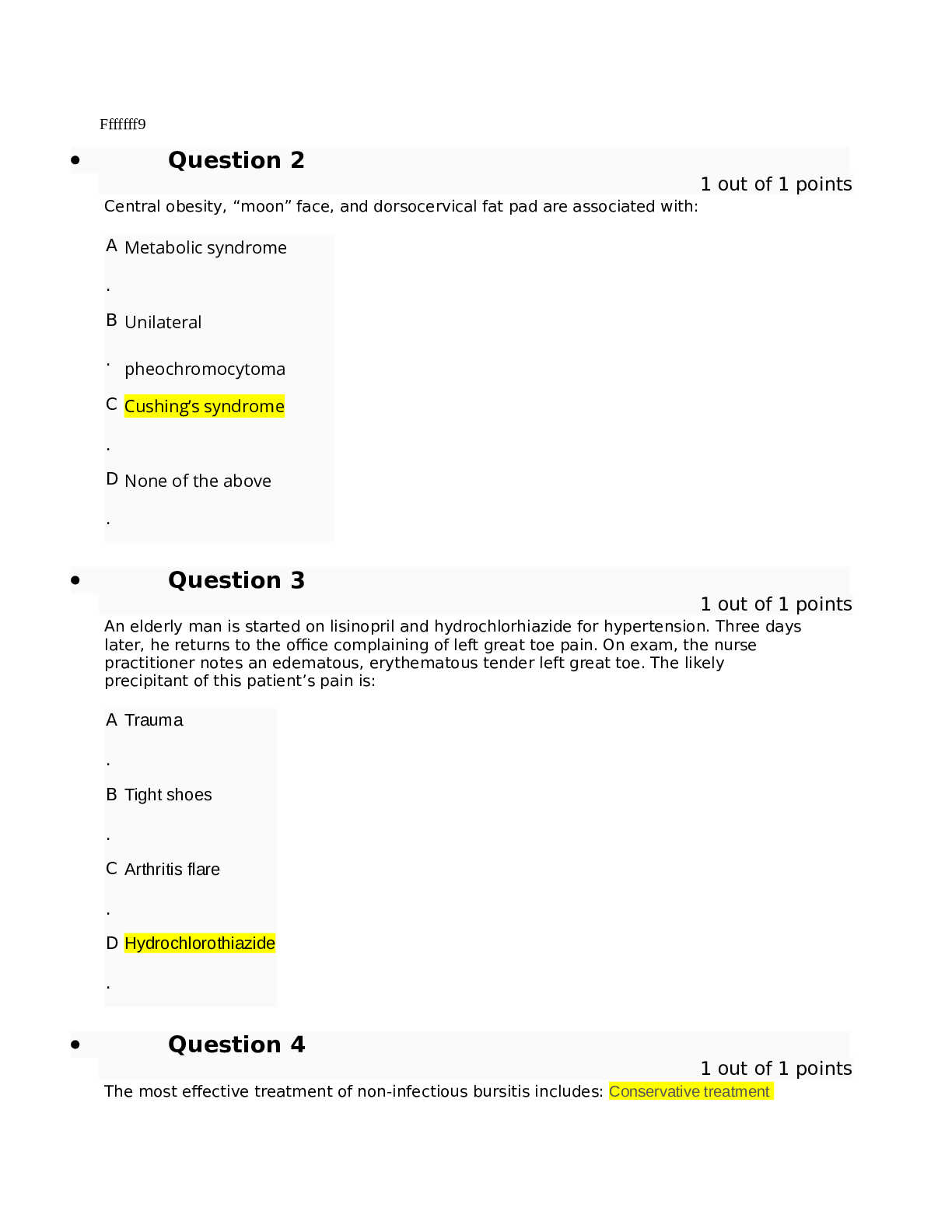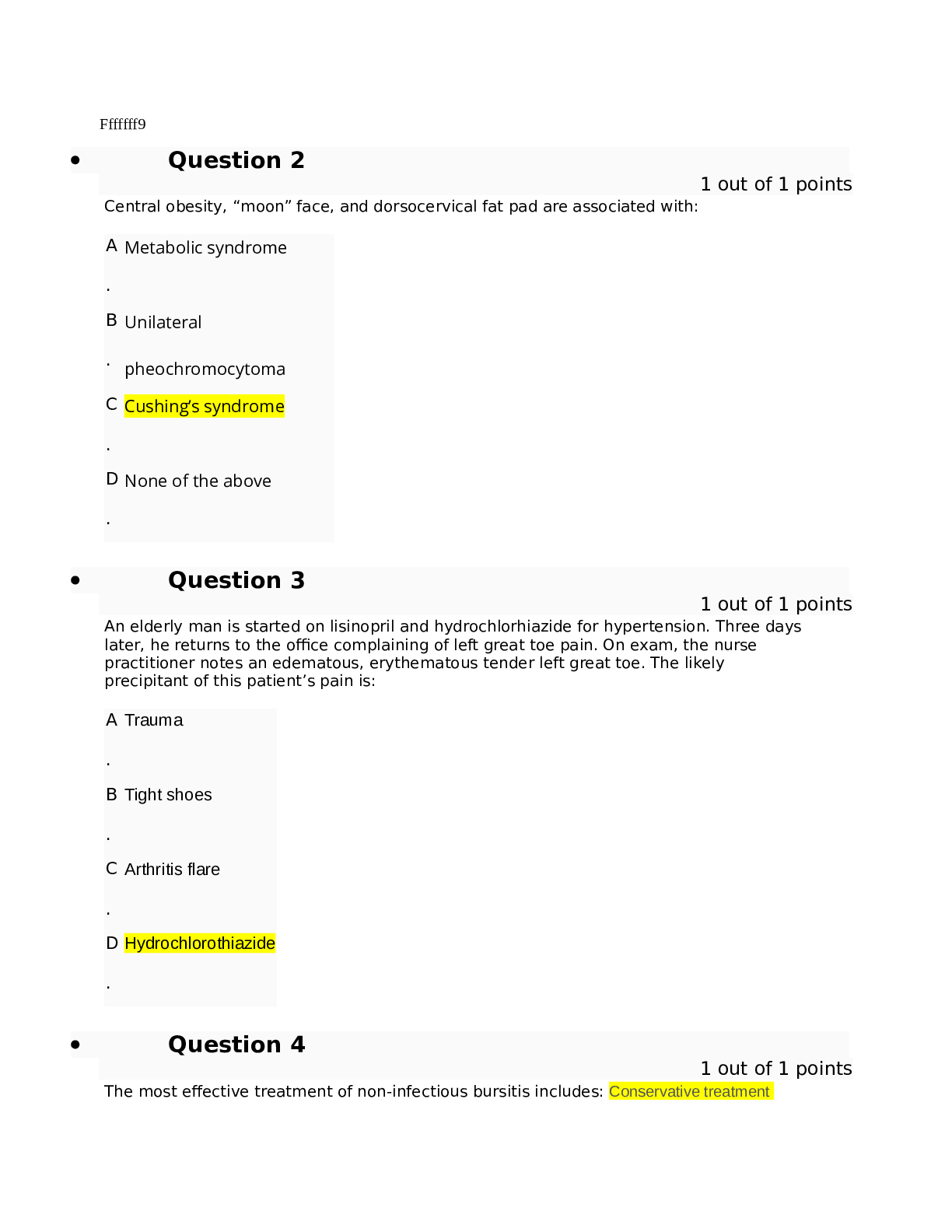Question 2
1 out of 1 points
Central obesity, “moon” face, and dorsocervical fat pad are associated with:
A.
Metabolic syndrome
B.
Unilateral
pheochromocytoma
C.
Cushing’s syndrome
D.
None of the above
Question 3
1 out of 1 points
An elderly man is started on lisinopril and hydrochlorhiazide for hypertension. Three days
later, he returns to the office complaining of left great toe pain. On exam, the nurse
practitioner notes an edematous, erythematous tender left great toe. The likely
precipitant of this patient’s pain is:
A.
Trauma
B.
Tight shoes
C.
Arthritis flare
D.
Hydrochlorothiazide
Question 4
1 out of 1 points
The most effective treatment of non-infectious bursitis includes: Conservative treatment
includes rest, cold and heat treatments, elevation, administration of nonsteroidal anti-inflammatory
drugs (NSAIDs), bursal aspiration, and intrabursal steroid injections
Question 5
1 out of 1 points
What conditions must be met for you to bill “incident to” the physician, receiving 100%
reimbursement from Medicare?
Selected
Answer: The physician must be on-site and engaged in
patient care
Answers: You must initiate the plan of care for the patient
The physician must be on-site and engaged in
patient care
You must be employed as an independent
contractor
You must be the main health care provider who
sees the patient
Question 6
1 out of 1 points
Which of the following is not a risk factor associated with the development of syndrome X
and type 2 diabetes mellitus?
The metabolic syndrome refers to the co-occurrence of several known cardiovascular risk factors,
including insulin resistance, obesity, atherogenic dyslipidemia and hypertension.
Question 7
1 out of 1 points
Which of the following is not a common early sign of benign prostatic hyperplasia (BPH)?
A. Nocturia
B. Urgency incontinence
C. Strong urinary stream flow
D. Straining to void
Question 8
1 out of 1 points
Steve, age 69, has gastroesophageal reflux disease (GERD). When teaching him how to
reduce his lower esophageal sphincter pressure, which substances do you recommend
that he avoid?
Food that is very hot or very cold
Fatty or fried foods
Peppermint or spearmint, including flavoring
Coffee, tea, and soft drinks that contain caffeine
Spicy, highly seasoned foods
Fried food DT caffeine, chocolate and anticholinergics
Question 9
1 out of 1 points
Which drug category contains the drugs that are the first line Gold standard therapy for
COPD?
Beta antagonist
Question 10
1 out of 1 points
The most commonly recommended pharmacological treatment regimen for low back pain
(LBP) is:
Nsaid
Question 11
1 out of 1 points
Which of the following is not appropriate suppression therapy for chronic bacterial
prostatitis?
Erythromycin
Question 12
1 out of 1 points
A patient presents with dehydration, hypotension, and fever. Laboratory testing reveals
hyponatremia, hyperkalemia, and hypoglycemia. These imbalances are corrected, but
the patient returns 6 weeks later with the same symptoms of hyperpigmentation,
weakness, anorexia, fatigue, and weight loss. What action(s) should the nurse
practitioner take?
.A Obtain a thorough history and physical, and check serum cortisol and ACTH
levels.
B. Perform a diet history and check CBC and FBS.
Read More


